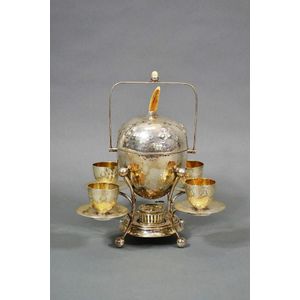Antique Mappin & Webb Egg Coddler with Boar's Tusk Finial
You must be a subscriber, and be logged in to view price and dealer details.
Subscribe Now to view actual auction price for this item
When you subscribe, you have the option of setting the currency in which to display prices to $Au, $US, $NZ or Stg.
- Ivory - Ivory is a hard white material that comes from the tusks of elephants, mammoth, walrus and boar, or from the teeth of hippopotamus and whales. The ivory from the African elephant is the most prized source of ivory. Although the mammoth is extinct, tusks are still being unearthed in Russia and offered for sale.
Ivory has been used since the earliest times as a material for sculpture of small items, both in Europe and the east, principally China and Japan.
In Asia ivory has been carved for netsuke, seals, okimono, card cases, fan supports, animals and other figures and even as carved tusks.
In the last 200 years in Europe ivory has been used to carve figures, for elaborate tankards, snuff boxes, cane handles, embroidery and sewing accessories, in jewellery and as inlay on furniture. Its more practical uses include being used for billiard balls, buttons, and a veneers on the top of piano keys.
The use and trade of elephant ivory have become controversial because they have contributed to Due to the decline in elephant populations because of the trade in ivory, the Asian elephant was placed on Appendix One of the Convention on International Trade in Endangered Species (CITES), in 1975, and in January 1990, the African elephant was similarly listed. Under Appendix One, international trade in Asian or African elephant ivory between member countries is forbidden. Unlike trade in elephant tusks, trade in mammoth tusks is legal.
Since the invention of plastics, there have been many attempts to create an artificial ivory - Finial - An architectural decoration, found on the upper parts of of an object. On furniture they are usually found on pediments, canopies and shelf supports. On smaller ceramic or silver items, such as spoons, they may decorate the top of the item itself, or the lid or cover where they provide a useful handle for removal.
Finials have a variety of shapes and forms. They may be urn-shaped, baluster shaped round or spiral, but usually taper into an upper point. Many real life shapes may also be used as finials, such as pineapples, berries, pinecones, buds, lotus and acorns. Sometimes animals such as a lion are depicted, or fish and dolphins. - Art and Crafts Movement - The Arts and Crafts movement began in Britain around 1880 and quickly spread across America and Europe. The Movement took its name from the Arts and Crafts Exhibition Society, founded in London 1887. One of the most influential figures behind the Arts and Crafts movements was the designer and writer William Morris. The movement continued until about 1920 and was followed by the Art Deco movement.
This item has been included into following indexes:
Visually similar items

A pair of French mother of pearl opera glasses with original leather case Lemaire of Paris 'Bee' maker mark

A late 19th century Italian Renaissance style walnut centre table with inset marble top, with carved acanthus leaf decoration, upon shaped trestle ends, with dragon heads and central putti, terminating in a moulded H stretcher with four turned baluster upr

A pair of jade and diamond drop earrings; each a 10.5 x 7.2 mm green jade to an 18ct white gold surmount set with 6 round brilliant cut diamonds. Length 22 mm.

A huon pine commode chair, Tasmanian, circa 1850, 92 cm high, 58 cm deep. Literature: Australian Furniture: Pictorial History and Dictionary, 1788-1938, Kevin Fahy and Andrew Simpson, Casuarina Press Ptd Ltd, Woollahra p. 249 (illustrated)
